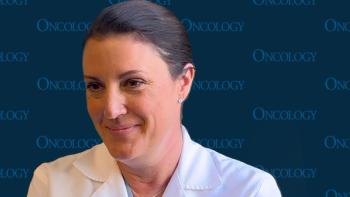
Oncology NEWS International
- Oncology NEWS International Vol 7 No 1
- Volume 7
- Issue 1
Update on Breast Cancer Chemoprevention Trials
SAN ANTONIO-With several tamoxifen (Nolvadex) chemoprevention trials now complete or nearing completion, “over the next 2 to 3 years, we will be able to see whether tamoxifen or other analogs will prevent breast cancer,” said Trevor J. Powles at the 20th Annual San Antonio Breast Cancer Symposium. He expressed confidence that these trials will prove that tamoxifen can prevent “a substantial amount of breast cancer in some populations of women.”
SAN ANTONIOWith several tamoxifen (Nolvadex) chemoprevention trials now complete or nearing completion, over the next 2 to 3 years, we will be able to see whether tamoxifen or other analogs will prevent breast cancer, said Trevor J. Powles at the 20th Annual San Antonio Breast Cancer Symposium. He expressed confidence that these trials will prove that tamoxifen can prevent a substantial amount of breast cancer in some populations of women.
Despite this optimism, Dr. Powles, head of the Breast Unit at Londons Royal Marsden Hospital, cautioned the audience never to forget that we are doing an intervention not in patients who already have breast cancer but in healthy women, where the risks involved could be very much more important than in patients being treated for cancer.
Summarizing the data compiled thus far from the completed Royal Marsden Hospital pilot trial (Tamoplac trial) and the Oxford metaanalysis on adjuvant tamoxifen, Dr. Powles concluded that the potential benefits of tamoxifen chemo-prevention still substantially outweigh the potential risks.
Begun in 1986, the Tamoplac trial compared 8 years of tamoxifen (10 mg/d) vs placebo in approximately 2,500 premenopausal and postmenopausal women who had a strong family history of breast cancer. (As Dr. Powles noted, the 8-year duration of chemoprevention was chosen before data from the adjuvant trials on the duration of tamoxifen therapy became available.)
Among the 2,500 women, there have been 56 cases of breast cancer and only four cases of endometrial cancer.
Dr. Powles called for an overview analysis in the year 2000 that would combine the results from the Tamoplac trial with data from the larger ongoing chemopre-vention trialsan Italian trial involving more than 4,000 women, a National Surgical Adjuvant Breast Project (NSABP) trial encompassing more than 13,000 women, and the International Breast-Cancer Intervention Study (IBIS) trial being conducted in more than 4,000 women around the world.
Such a metaanalysis would not only definitively establish the potential benefits of tamoxifen, he asserted, but also allow for subgroup analyses that would enable investigators to pinpoint specific groups of women who are most likely to benefit from antiestrogen prophylaxis.
Dr. Powles believes that identification of these subgroups is an extremely important issue because, in the end, we do not want to be treating everyone.
Newer Agents
Another essential aim of the next generation of trials is the identification of other tamoxifen-like drugs that have a wide spectrum of attractive actions but lack major undesirable effects.
The ideal chemopreventive agent for use in women at risk for breast cancer, Dr. Powles said, would lower cholesterol, preserve bone, and cause an atrophic endometrium without exerting stromal effects on the uterus. Such an agent would not induce breast proliferation and thus would prevent breast cancer development, and would not be genotoxic.
Agents that may fulfill these criteria are currently being tested, he noted. One such agent, raloxifene (Evista), recently received FDA approval for the prevention of osteoporosis and may prove to be useful in preventing breast cancer as well.
Another promising antiestrogen agent, toremifene (Fareston) has just been approved by the FDA for the treatment of metastatic breast cancer (see page 30). Toremifene has not caused endometrial proliferation, has been shown to preserve bone and improve lipids, and does not appear to be genotoxic, Dr. Powles said.
A phase II/III prevention trial comparing toremifene, tamoxifen, and placebo is currently underway at the Royal Marsden Hospital.
Dr. Powles reminded the audience that despite extensive experience with tam-oxifen in over 3 million patients, researchers in the 1980s had no evidence of, nor did they anticipate, the drugs potential uterine or genotoxic effects.
When we start looking at che-moprevention in healthy women using newer agents, we must be aware of what might be out there that we dont know about and havent thought about with these drugs, he stressed.
Articles in this issue
almost 28 years ago
Interferon Improves Survival In CML: 10-Year Follow-upalmost 28 years ago
Topotecan Plus Cytarabine Promising in MDSalmost 28 years ago
Update of Letrozole Pivotal Trials in Advanced Breast Canceralmost 28 years ago
Arguments Against Mammograms for Age 40-49 Refutedalmost 28 years ago
Proton Beam Therapy Appears Safer than Prostatectomy, X-raysalmost 28 years ago
RT Effective Palliation for Malignant Melanomaalmost 28 years ago
Metastatic Breast Cancer Responds to Docetaxel, Doxorubicin, Cytoxanalmost 28 years ago
Prevention of Breast Cancer Begins With Public Health Education on Risksalmost 28 years ago
Amifostine Reduces RT-Related Dry Mouth in H&N CancerNewsletter
Stay up to date on recent advances in the multidisciplinary approach to cancer.

















































































